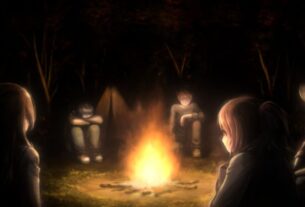
It’s truly rare for me to find a game that makes me feel the way Ring of Pain does. On one hand, I love its gameplay loop. Upgrading stats, scoring loot, fighting monsters, and taking risks are rarely as compelling and satisfying as they are here. But the game is also horribly unfair in ways that can’t be overstated. In spite of that, it nails the “one more run” incentive better than most, but anyone turned off by having the decks quite literally stacked against them might find it too infuriating to be worth sinking time into.
Ring of Pain tells the story of a person in a tower. Or something. I don’t actually know. The not-tower exists because it’s a part of them and they need to escape or stay there. There are really only two characters to gather lore from: one inert and consistently useless, and the other obviously evil. One of them (and I won’t say which one’s which, but c’mon) is a bird-person called Owl who looks like they escaped from Freddy Fazbear’s. The other is a shadow person. You can go in and talk to them, but they repeat their dialogue incessantly and speak in rhymes that don’t flow very well.
But no one is playing Ring of Pain for the lore. They’re playing it because they hate themselves and 2020 somehow hasn’t caused them enough suffering without them having to pay for more. The game is a rogue-lite, and playing it unlocks new items that show up on subsequent runs. There are no passive bonuses to acquire, so you’ll need to make use of the new items, your wits, and a massive amount of luck to see your way through the game’s two different routes that you’ll select after completing the 16th depth of the not-tower.
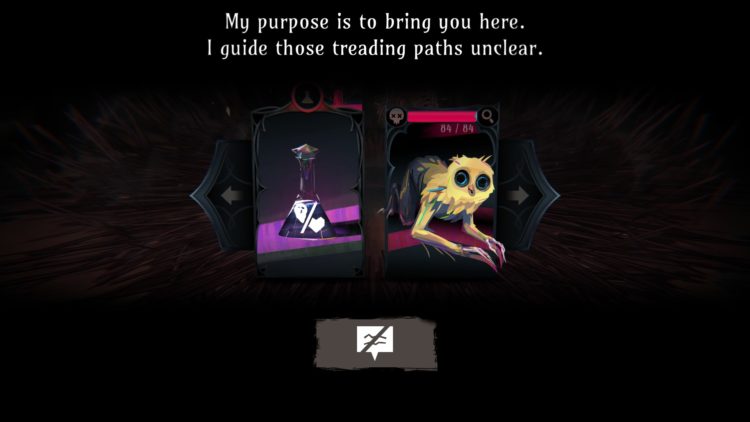
I will make you hurt
Ring of Pain is titled as it is for very specific reasons. I’ve gone into the pain a bit, but rings are prevalent in every moment of the gameplay. You begin each run in the first depth, a self-contained dungeon with a ring of cards. Cards come in several varieties: enemies, stat increases, single and multiple-use items, potions, equipment, and doors. You’ll need to rotate through the cards one by one to move through the dungeon with the goal of reaching the exit. There are often multiple types of doors that will lead to different depths. Some are safe havens, others are extremely dangerous. The choice is yours.
You’ll immediately want to seek out stat-increases and equipment in order to buff your stats and obtain passive abilities. Stats are divided up by attack, defense, speed, and clarity, which your enemies all have as well. How much damage you do and take will depend on how your stats compare to that of your foes. For instance, the difference between your attack and your enemy’s defense will dictate how much damage you do. If your speed is higher than theirs and you do more damage than they have health, they’ll die without hitting you.
Whenever an enemy dies, you gain souls that can be spent in shops or to unlock color-graded chests with equipment in them. It’s extremely important to get higher-tier gear, but those chests are much more expensive, meaning that you’ll have to think carefully about when to buy anything. Many of the potions and stat increases have a curse mechanic. If you’re lucky, you’ll heal or get a stat increase. If not, you’ll take a large amount of curse damage. There’ll be plenty of situations where you’re low on health and chugging a curse potion is your only way out alive. Drinking that potion will very frequently make things worse instead of better. Risk and reward, baby.
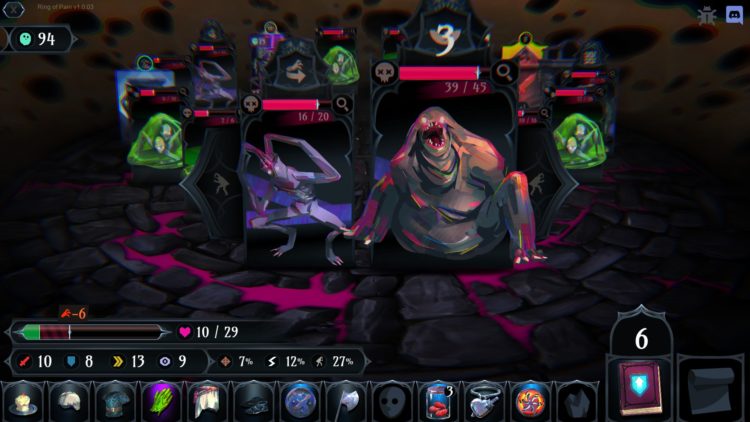
As the ring turns
Further complicating matters, Ring of Pain is turn-based. Not all enemies move, but the ones that do, hoo boy. There’s one that moves around the entire ring in one direction. Exploding enemies also love to move toward you and blow up, which you can use to chain detonations or damage nearby enemies. You can attempt to pass all enemies, but if you fail the stealth check, you’ll take full damage from their attack. You have a stealth stat that starts at 20-ish percent, and it can be increased with certain pieces of equipment. The kicker is that certain enemies are so powerful that attempting to pass them can either kill you outright or come close, which is where the usable items come into play. These give you guaranteed stealth, healing, and a variety of other moves.
But those enemies that can easily one-shot you are where so much of the titular pain in Ring of Pain comes from. One of the game’s most frequent causes of death is that you’ll find yourself trapped between two enemies that will kill you if they hit you. If you happen to have an item handy, you can use it to get by them. If you don’t, you’ll have to take your chances by leaning on your stealth stat. Naturally, if they hit you, it’s game over. And these situations occur with a very high degree of frequency. Lower-numbered depths aren’t a problem, but once you get half way, things get dicey.
You can easily enter a dungeon, move in one direction, and find an enemy you can’t bypass. Moving in the other direction might result in a similarly unfavorable scenario. And these tend to happen multiple times per run so, even if you get out of one, you can run into another in the same dungeon. I can’t tell you how many times I successfully sneaked past a lurker only to find something just as insta-killy on the other side. My point is that failure in Ring of Pain will often occur through no fault of your own.
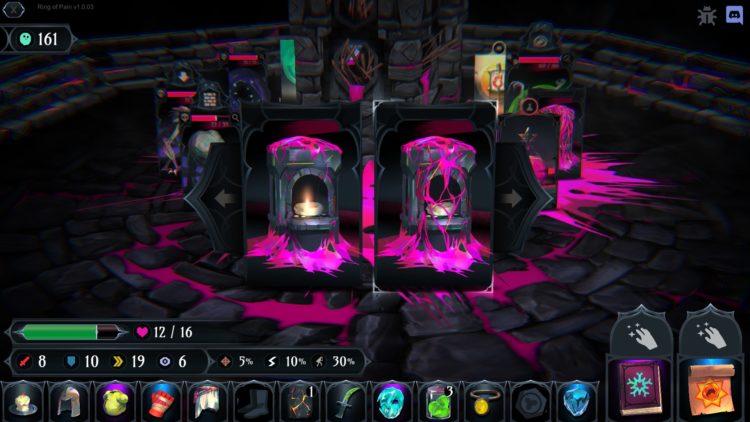
Born to die
Ring of Pain is great. The mechanics are excellent, the art is creepy, and the setup and execution are unique. But the extremely unfair situations don’t ever let up. At over 20 hours of playtime, I’ve yet to have favorable circumstances that allowed me to be powerful/lucky enough to successfully win a run. Just today, I got so close. I got one of the bosses down to half health and, through a combination of careful play and item synergy; it was only a matter of time before I bested them. But then two extremely powerful enemies spawned to either side of me and I had no more items. I attempted to sneak past one and it killed me. I simply got dealt a bad hand. Another time I was strong enough to one-shot everything in my path but I couldn’t beat the boss because they were almost never vulnerable. Eventually, I killed everything until it was just the two of us and my only option was to hit them and die instantly.
In that way, Ring of Pain very much reminds me of any digital versions of Solitaire that have an unbalanced win/lose ratio. When you start a new run, you’ll have very little chance of success for purely luck-based reasons. In spite of this, I greatly enjoy playing the game, but I think that’s a very important caveat to mention. It’s an excellent game with a lot of great ideas. But enjoying it requires you to know that you’re oftentimes going to get punished solely for booting it up. If that leaves you undaunted, then I highly recommend this game. However, your blood pressure probably won’t thank you.
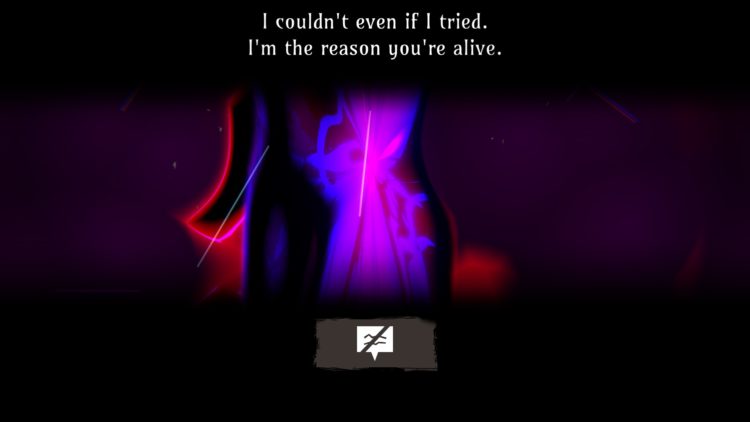
Ring of Pain
Ring of Pain is an immensely enjoyable experience that can be monumentally frustrating due to its luck-focused nature. It has excellent mechanics and really has a way of worming itself into your brain. But it can be horribly aggravating all the same.

